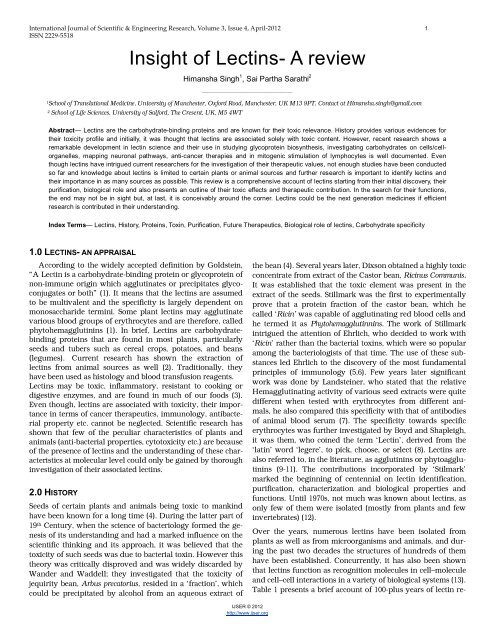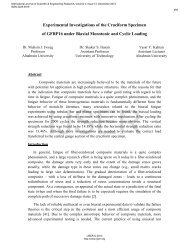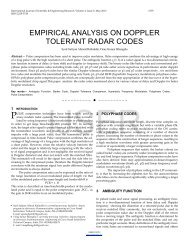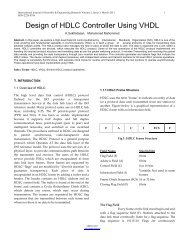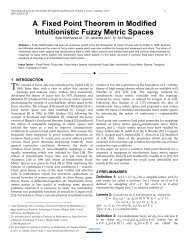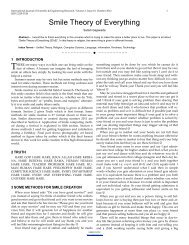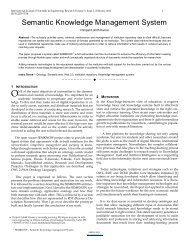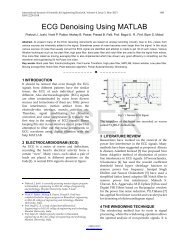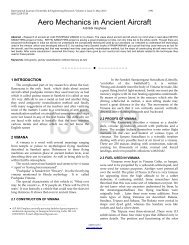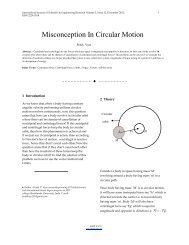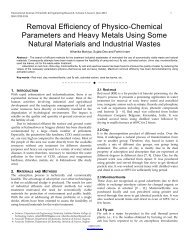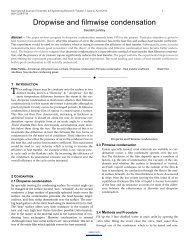Insight of Lectins- A review - International Journal of Scientific and ...
Insight of Lectins- A review - International Journal of Scientific and ...
Insight of Lectins- A review - International Journal of Scientific and ...
You also want an ePaper? Increase the reach of your titles
YUMPU automatically turns print PDFs into web optimized ePapers that Google loves.
<strong>International</strong> <strong>Journal</strong> <strong>of</strong> <strong>Scientific</strong> & Engineering Research, Volume 3, Issue 4, April-2012 1<br />
ISSN 2229-5518<br />
<strong>Insight</strong> <strong>of</strong> <strong>Lectins</strong>- A <strong>review</strong><br />
Himansha Singh 1 , Sai Partha Sarathi 2<br />
————————————————<br />
1School <strong>of</strong> Translational Medicine, University <strong>of</strong> Manchester, Oxford Road, Manchester, UK M13 9PT. Contact at Himansha.singh@gmail.com<br />
2 School <strong>of</strong> Life Sciences, University <strong>of</strong> Salford, The Cresent, UK, M5 4WT<br />
Abstract— <strong>Lectins</strong> are the carbohydrate-binding proteins <strong>and</strong> are known for their toxic relevance. History provides various evidences for<br />
their toxicity pr<strong>of</strong>ile <strong>and</strong> initially, it was thought that lectins are associated solely with toxic content. However, recent research shows a<br />
remarkable development in lectin science <strong>and</strong> their use in studying glycoprotein biosynthesis, investigating carbohydrates on cells/cellorganelles,<br />
mapping neuronal pathways, anti-cancer therapies <strong>and</strong> in mitogenic stimulation <strong>of</strong> lymphocytes is well documented. Even<br />
though lectins have intrigued current researchers for the investigation <strong>of</strong> their therapeutic values, not enough studies have been conducted<br />
so far <strong>and</strong> knowledge about lectins is limited to certain plants or animal sources <strong>and</strong> further research is important to identify lectins <strong>and</strong><br />
their importance in as many sources as possible. This <strong>review</strong> is a comprehensive account <strong>of</strong> lectins starting from their initial discovery, their<br />
purification, biological role <strong>and</strong> also presents an outline <strong>of</strong> their toxic effects <strong>and</strong> therapeutic contribution. In the search for their functions,<br />
the end may not be in sight but, at last, it is conceivably around the corner. <strong>Lectins</strong> could be the next generation medicines if efficient<br />
research is contributed in their underst<strong>and</strong>ing.<br />
Index Terms— <strong>Lectins</strong>, History, Proteins, Toxin, Purification, Future Therapeutics, Biological role <strong>of</strong> lectins, Carbohydrate specificity<br />
1.0 LECTINS- AN APPRAISAL<br />
According to the widely accepted definition by Goldstein,<br />
“A Lectin is a carbohydrate-binding protein or glycoprotein <strong>of</strong><br />
non-immune origin which agglutinates or precipitates glycoconjugates<br />
or both” (1). It means that the lectins are assumed<br />
to be multivalent <strong>and</strong> the specificity is largely dependent on<br />
monosaccharide termini. Some plant lectins may agglutinate<br />
various blood groups <strong>of</strong> erythrocytes <strong>and</strong> are therefore, called<br />
phytohemagglutinins (1). In brief, <strong>Lectins</strong> are carbohydratebinding<br />
proteins that are found in most plants, particularly<br />
seeds <strong>and</strong> tubers such as cereal crops, potatoes, <strong>and</strong> beans<br />
(legumes). Current research has shown the extraction <strong>of</strong><br />
lectins from animal sources as well (2). Traditionally, they<br />
have been used as histology <strong>and</strong> blood transfusion reagents.<br />
<strong>Lectins</strong> may be toxic, inflammatory, resistant to cooking or<br />
digestive enzymes, <strong>and</strong> are found in much <strong>of</strong> our foods (3).<br />
Even though, lectins are associated with toxicity, their importance<br />
in terms <strong>of</strong> cancer therapeutics, immunology, antibacterial<br />
property etc. cannot be neglected. <strong>Scientific</strong> research has<br />
shown that few <strong>of</strong> the peculiar characteristics <strong>of</strong> plants <strong>and</strong><br />
animals (anti-bacterial properties, cytotoxicity etc.) are because<br />
<strong>of</strong> the presence <strong>of</strong> lectins <strong>and</strong> the underst<strong>and</strong>ing <strong>of</strong> these characteristics<br />
at molecular level could only be gained by thorough<br />
investigation <strong>of</strong> their associated lectins.<br />
2.0 HISTORY<br />
Seeds <strong>of</strong> certain plants <strong>and</strong> animals being toxic to mankind<br />
have been known for a long time (4). During the latter part <strong>of</strong><br />
19 th Century, when the science <strong>of</strong> bacteriology formed the genesis<br />
<strong>of</strong> its underst<strong>and</strong>ing <strong>and</strong> had a marked influence on the<br />
scientific thinking <strong>and</strong> its approach, it was believed that the<br />
toxicity <strong>of</strong> such seeds was due to bacterial toxin. However this<br />
theory was critically disproved <strong>and</strong> was widely discarded by<br />
W<strong>and</strong>er <strong>and</strong> Waddell; they investigated that the toxicity <strong>of</strong><br />
jequirity bean, Arbus precatorius, resided in a ‘fraction’, which<br />
could be precipitated by alcohol from an aqueous extract <strong>of</strong><br />
the bean (4). Several years later, Dixson obtained a highly toxic<br />
concentrate from extract <strong>of</strong> the Castor bean, Ricinus Communis.<br />
It was established that the toxic element was present in the<br />
extract <strong>of</strong> the seeds. Stillmark was the first to experimentally<br />
prove that a protein fraction <strong>of</strong> the castor bean, which he<br />
called ‘Ricin’ was capable <strong>of</strong> agglutinating red blood cells <strong>and</strong><br />
he termed it as Phytohemagglutinnins. The work <strong>of</strong> Stillmark<br />
intrigued the attention <strong>of</strong> Ehrlich, who decided to work with<br />
‘Ricin’ rather than the bacterial toxins, which were so popular<br />
among the bacteriologists <strong>of</strong> that time. The use <strong>of</strong> these substances<br />
led Ehrlich to the discovery <strong>of</strong> the most fundamental<br />
principles <strong>of</strong> immunology (5,6). Few years later significant<br />
work was done by L<strong>and</strong>steiner, who stated that the relative<br />
Hemagglutinating activity <strong>of</strong> various seed extracts were quite<br />
different when tested with erythrocytes from different animals,<br />
he also compared this specificity with that <strong>of</strong> antibodies<br />
<strong>of</strong> animal blood serum (7). The specificity towards specific<br />
erythrocytes was further investigated by Boyd <strong>and</strong> Shapleigh,<br />
it was them, who coined the term ‘Lectin’, derived from the<br />
‘latin’ word ‘legere’, to pick, choose, or select (8). <strong>Lectins</strong> are<br />
also referred to, in the literature, as agglutinins or phytoagglutinins<br />
(9-11). The contributions incorporated by ‘Stilmark’<br />
marked the beginning <strong>of</strong> centennial on lectin identification,<br />
purification, characterization <strong>and</strong> biological properties <strong>and</strong><br />
functions. Until 1970s, not much was known about lectins, as<br />
only few <strong>of</strong> them were isolated (mostly from plants <strong>and</strong> few<br />
invertebrates) (12).<br />
Over the years, numerous lectins have been isolated from<br />
plants as well as from microorganisms <strong>and</strong> animals, <strong>and</strong> during<br />
the past two decades the structures <strong>of</strong> hundreds <strong>of</strong> them<br />
have been established. Concurrently, it has also been shown<br />
that lectins function as recognition molecules in cell–molecule<br />
<strong>and</strong> cell–cell interactions in a variety <strong>of</strong> biological systems (13).<br />
Table 1 presents a brief account <strong>of</strong> 100-plus years <strong>of</strong> lectin re-<br />
IJSER © 2012<br />
http://www.ijser.org
<strong>International</strong> <strong>Journal</strong> <strong>of</strong> <strong>Scientific</strong> & Engineering Research Volume 3, Issue 4, March-2012 2<br />
ISSN 2229-5518<br />
search <strong>and</strong> show how these proteins have become the focus <strong>of</strong><br />
intense interest for biologists <strong>and</strong> in particular for the glycobiologists<br />
among them.<br />
Table 1 History <strong>of</strong> <strong>Lectins</strong><br />
Year Scientist Contribution<br />
1884 Warden & Waddel Toxiciy in Abrus precatorius seed extracts<br />
1886 Dixson Toxicity in Ricinus communis seed extracts<br />
1888 Stillmark Hemagglutinating activity in Ricinus<br />
communis seed extracts<br />
Toxicity in Croton triglium seed extracts<br />
1890 Power & Cambier Toxicity in Robinia pseudoacacia seed<br />
extracts<br />
1890 Erlich Use <strong>of</strong> abrin an ricin in immunological<br />
research<br />
1891 Hellin Hemagglutinating activity in Abrus<br />
precatorius seed extracts<br />
1893 Siegel Hemagglutinating activity in Jatropha<br />
curcas seed extracts<br />
1897 Elfstr<strong>and</strong> Hemagglutinating activity in Croton<br />
triglium seed extracts<br />
1899 Camus Hemagglutinating activity in Helix<br />
pomatia<br />
1902 L<strong>and</strong>steiner Reversibility <strong>of</strong> the hemagglutination by<br />
heat<br />
1902 Kauss Inhibition <strong>of</strong> the hemagglutinating activity<br />
by non-immune serum<br />
1903 Noguchi Hemagglutinating activity in horseshoe<br />
crab<br />
1907 L<strong>and</strong>steiner & Hemagglutinating activity in non-toxic<br />
Raubitschek<br />
plants<br />
1908 Wienhaus Agglutination <strong>of</strong> leucocytes <strong>and</strong> kidney<br />
<strong>and</strong> liver cells by Phaseolus vulgaris<br />
Species specificity <strong>of</strong> plant<br />
hemagglutinatins<br />
1908 L<strong>and</strong>steiner &<br />
Raubitschek<br />
1909 Mendel Hemagglutinating activity in Robinia<br />
pseudoacacia seed extracts<br />
1909 L<strong>and</strong>steiner Inhibition <strong>of</strong> hemagglutinating activity by<br />
heat treated serum<br />
1909 L<strong>and</strong>steiner & Inhibition <strong>of</strong> the heagglutinating activity<br />
Raubitschek<br />
by mucin<br />
1912 Schneider Hemagglutinins <strong>and</strong> germination<br />
1917 Sumner Isolation <strong>and</strong> crystallization <strong>of</strong><br />
Concanavalina A (Con a)<br />
19126-7 Marcusson-<br />
Aplicability <strong>of</strong> lectins for blood typing<br />
Begun/Siever<br />
1935 Sugishita Specificity <strong>of</strong> eel serum agglutinins<br />
1936 Sumner & Howell Sugar specificity <strong>of</strong> Concanavalin A<br />
1947-9 Boyd & Blood group specificity <strong>of</strong> plant<br />
Reguera/Renkonen heagglutinins<br />
IJSER © 2012<br />
http://www.ijser.org
<strong>International</strong> <strong>Journal</strong> <strong>of</strong> <strong>Scientific</strong> & Engineering Research Volume 3, Issue 4, March-2012 3<br />
ISSN 2229-5518<br />
1949 Liener Toxicity <strong>of</strong> Phaseolus vulgaris<br />
hemagglutinins<br />
1949 Jaffe Thermoinactivaation <strong>of</strong> Phaseolus vulgaris<br />
hemagglutinins<br />
1952 Watkins & Morgan Inhibition <strong>of</strong> lectins by simpe sugars<br />
1954 Boyd & Sharpleigh Introduction <strong>of</strong> the term lectin<br />
1960 Nowell Mitogenic stimulation <strong>of</strong> lymphocytes by<br />
Phaseolus vulgaris lectin<br />
1963 Aub Agglutination <strong>of</strong> malignant cells by lectins<br />
1964 Muclenaere Parallel inactivation <strong>of</strong> hemagglutinating<br />
<strong>and</strong> antinutritional activity by heat<br />
1965 Agrawal & Goldstein Affinity chromatography for lectin<br />
purification<br />
1966 Boyd <strong>Lectins</strong> in algae<br />
1970 Apsberg et al. Use <strong>of</strong> Con A for affinity purification <strong>of</strong><br />
glycoproteins<br />
1974 Ashwell & Morel Role <strong>of</strong> animal lectins in endocytosis <strong>of</strong><br />
glycoproteins<br />
1976 Gallo Interleukin 2 dissolved in medium <strong>of</strong> lectin<br />
stimulated lymphocytes<br />
1977 Ofek et al. Role <strong>of</strong> bacterial lectins in infection<br />
1980 Pusztai Interaction <strong>of</strong> Phaseolus vulgaris lectin<br />
with intestinal wall<br />
1981 Reisner et al. Use <strong>of</strong> lectins in bone marrow<br />
transplantation<br />
1984 Yajko et al. Combined use <strong>of</strong> lectin <strong>and</strong> enzyme in<br />
clinical identification <strong>of</strong> micro-organism<br />
1987 Harban-Mendoza et Control <strong>of</strong> root-knot nematodes by lectins<br />
al.<br />
1988 De Oliveira et al. Lectin <strong>and</strong> pancreas hyperthropy<br />
1989 Diaz et al. Root lectin as a specificity determinant in<br />
the Rhizobium-legume symbiosis<br />
1990 Yamauchi & Con A expression in Escherichia coli cells<br />
Minamikawa<br />
!<br />
IJSER © 2012<br />
http://www.ijser.org
<strong>International</strong> <strong>Journal</strong> <strong>of</strong> <strong>Scientific</strong> & Engineering Research Volume 3, Issue 4, March-2012 4<br />
ISSN 2229-5518<br />
Until the early 1970s, although the presence <strong>of</strong> lectins was<br />
reported in numerous organisms, especially in plants, only<br />
few <strong>of</strong> them had been purified, <strong>and</strong> almost all the purification<br />
was performed by conventional techniques such as saltinduced<br />
crystallization, ethanol precipitation, ion exchange<br />
chromatography <strong>and</strong> gel filtration (13). Some <strong>of</strong> the earlypurified<br />
lectins include plant lectins from soya beans, green<br />
peas, Dolichos biflorus seeds, wheat germ, <strong>and</strong> mushroom<br />
(Agaricus campestris) (12-13), <strong>and</strong> animal lectins <strong>of</strong> eel (13-14),<br />
<strong>and</strong> snail (2). These conventional methods relied on the<br />
physicochemical properties <strong>of</strong> the proteins for separation.<br />
The introduction <strong>of</strong> Affinity chromatography for the<br />
purification <strong>of</strong> lectins was a turning point in the field <strong>of</strong><br />
lectinology <strong>and</strong> immensely increased the pace <strong>of</strong> purification<br />
<strong>of</strong> lectins from various sources (15-16, 30). Affinity<br />
chromatography depends on the specific interaction between<br />
the lectin <strong>and</strong> a carbohydrate structure attached to an inert<br />
matrix (30). This breakthrough discovery led the easy<br />
availability <strong>of</strong> numerous lectins for a small period <strong>of</strong> time.<br />
However, even then, plants remained the primary source for<br />
the supply <strong>of</strong> lectins. Although the occurrence <strong>of</strong> lectins in<br />
animals was noted quite early, almost in all invertebrates <strong>and</strong><br />
in lower vertebrates, only the aforementioned three animals<br />
(eel, snail, <strong>and</strong> horseshoe crab) were actually isolated <strong>and</strong><br />
characterised. The first lectin from the animal source, shown<br />
to be specific for a sugar (L-fucose), was from the eel (17).<br />
<strong>Lectins</strong> are found in almost all edible plants <strong>and</strong> exposure <strong>of</strong><br />
men <strong>and</strong> animals to lectins is inevitable. The majority <strong>of</strong> plant<br />
lectins are present in seed cotyledons, where they are found in<br />
cytoplasm or they may also be present in protein bodies (18-<br />
19). Some lectins such as ‘ricin’ <strong>and</strong> ‘abrin’ are highly toxic; the<br />
general public became aware <strong>of</strong> toxicity <strong>of</strong> ricin after the<br />
murder <strong>of</strong> ‘Georgi Markov’ a Bulgarian writer. Even during<br />
World War II, ricin bomb was developed <strong>and</strong> tested in British<br />
military, but was never used as bio-weapons (13).<br />
3.0 Carbohydrate Specificty<br />
Based on the amino acid sequences <strong>of</strong> available lectins, it is<br />
deduced that the carbohydrate binding property <strong>of</strong> most<br />
lectins resides in a polypeptide sequence, which is termed as<br />
‘Carbohydrate-recognition domain’ (20). Generally, lectins are<br />
classified in five groups on the basis <strong>of</strong> their affinity for (i)<br />
Glucose/Mannose; (ii) Galactose <strong>and</strong> N-acetyl-Dgalactosamine;<br />
(iii) N-acetylglucosamine; (iv) L-fucose, <strong>and</strong> (v)<br />
Sialic acid (11). Source <strong>and</strong> specificities <strong>of</strong> lectins are<br />
summarised in Table 2. The binding with simple or complex<br />
carbohydrate conjugates is reversible <strong>and</strong> non-covalent. The<br />
specificity <strong>of</strong> lectins towards carbohydrates can be defined on<br />
the basis <strong>of</strong> ‘Hapten inhibition test’, in which various sugars or<br />
saccharides are tested for their capacity to inhibit the property<br />
<strong>of</strong> hemagglutination <strong>of</strong> erythrocytes. The binding property <strong>of</strong><br />
many lectins can be affected by more than one carbohydrate<br />
moiety; this is because each lectin molecule possesses two or<br />
more carbohydrate-binding sites that are essential for their<br />
ability to agglutinate cells or to react with complex<br />
carbohydrates (22). Hapten inhibition test is commonly used<br />
for identification <strong>of</strong> lectin specificity in present days.<br />
Table 2 Sources <strong>and</strong> specificity <strong>of</strong> few <strong>of</strong> the common lectins<br />
(Gal, Galactose; Fuc = fucose; Glc = glucose; GalNAc, N-<br />
acetylgalactosamine; GlcNAc, N-acetylglucosamine; Man,<br />
mannose) (21)<br />
Systemic Name <strong>of</strong><br />
the plant source<br />
Common Name<br />
4.0 Biological Role<br />
Preferred<br />
Abbreviation<br />
Specifity<br />
Aaptos papilleta Sponge AAP GlcN Ac<br />
Abrus precatorius Jequirty bean APA Gal, GalNAc<br />
Aegapodium<br />
podagraria<br />
Agaricus bisporus<br />
Albizzia<br />
julibrissin<br />
Allomyrina<br />
dichotoma<br />
Ground elder APP Complex<br />
Common<br />
mushroom<br />
ABA<br />
Complex<br />
Mimosa tree seed ALJ Nonspecific<br />
Japanese beetle AlloA Gal, GlcAc<br />
Aloe arborescens Aloe plant AAR Nonspecific<br />
Amphicarpaea<br />
bracteata<br />
Hog peanut AMB GalNAc<br />
Anguilla Anguilla Eel AAA Fuc<br />
Aplysia depilans Molluse from<br />
Mediterranean sea<br />
AGL<br />
Galacturonic acidGal<br />
Arachis hypogaea Peanut PNA Gal, GalNH2<br />
Artocarpus<br />
heterophullus<br />
Bauhinia<br />
purpurea<br />
Jacalin JCA Complex<br />
Camel’s foot tree BPA GalNAc, Gal<br />
Bryonia diocia White bryony BDA Complex<br />
Canavalia<br />
ensiformis<br />
Caragana<br />
Arborescens<br />
Carcinoscorpius<br />
rotundacauda<br />
Jack Bean Con A Man,Glc<br />
Siberian pea tree CGA GalN Ac<br />
Horseshoe crab CCN Sialic Acid<br />
The biological role <strong>of</strong> lectins is based on conjecture rather than<br />
knowledge. The question <strong>of</strong> the possible physiological role <strong>of</strong><br />
lectins has intrigued investigators from the beginning <strong>and</strong> the<br />
main highlight has been given to plant derived lectins, which<br />
for a long time were virtually the only ones known (23). It has<br />
been reported that feeding bruchid beetles with a diet<br />
containing ‘the black bean’ lectin resulted in the death <strong>of</strong> the<br />
bruchid larvae (24). On this basis, scientists concluded that the<br />
major role <strong>of</strong> lectins in legumes could be related to protection<br />
from attack by insect seed predators. In addition, it was found<br />
IJSER © 2012<br />
http://www.ijser.org
<strong>International</strong> <strong>Journal</strong> <strong>of</strong> <strong>Scientific</strong> & Engineering Research Volume 3, Issue 4, March-2012 5<br />
ISSN 2229-5518<br />
that lectins may be involved in protection <strong>of</strong> plants against<br />
pathogenic microorganisms as well based on the observation<br />
that showed that WGA, PNA, <strong>and</strong> SBA inhibited the<br />
sporulation <strong>and</strong> growth <strong>of</strong> fungi such as Trichoderma viride,<br />
Penicilium notatum, <strong>and</strong> Aspergillus niger (25). Researchers<br />
found that the major carbohydrate specificity groups <strong>of</strong> about<br />
11 lectins were all found to cause growth disruption during<br />
germination <strong>of</strong> spores <strong>of</strong> Neurospora crassa, Aspergillus<br />
amstelodami, <strong>and</strong> Botryodiplodia theobromae (26).<br />
Furthermore, it is speculated that lectins are involved in sugar<br />
transport or carbohydrate storage, because <strong>of</strong> their role in<br />
adhesion <strong>and</strong> agglutination. <strong>Lectins</strong> have also been considered<br />
to be important in both symbiotic as well as in pathogenic<br />
interaction between some microorganisms <strong>and</strong> host. They also<br />
play important role in microbial adhesion to various surfaces;<br />
they can bind to mucosal membrane <strong>and</strong> resist denaturation<br />
by acid as well as by proteolytic enzymes (27-28). <strong>Lectins</strong> are<br />
also shown responsible for the specific association between<br />
nitrogen-fixing rhizobia <strong>and</strong> leguminous plants, which<br />
provides the plant with the needed nitrogen, was advanced<br />
nearly three decades ago (29). It was based on the theory that<br />
lectin from a particular legume was bound to the surface<br />
polysaccharide or lipopolysaccharide <strong>of</strong> the corresponding<br />
rhizobial species, but not to bacteria that are symbionts <strong>of</strong><br />
other legumes The suggestion has therefore been made that<br />
rhizobial attachment to plant roots occurs by interaction<br />
between the bacterial surface carbohydrates <strong>and</strong> lectins<br />
present in the roots <strong>of</strong> the leguminous plants. This is known as<br />
the lectin recognition hypothesis <strong>and</strong> still the subject <strong>of</strong><br />
controversy, because <strong>of</strong> the lack <strong>of</strong> unequivocal evidence.<br />
<strong>Lectins</strong> serve as means <strong>of</strong> attachment <strong>of</strong> different kinds <strong>of</strong> cells<br />
as well as <strong>of</strong> viruses to other cells via the surface<br />
carbohydrates <strong>of</strong> the cells to be attached (28). In some cases,<br />
cell surface lectins bind to particular glycoproteins, whereas in<br />
other cases the carbohydrates <strong>of</strong> cell surface glycoproteins or<br />
glycolipids serve as sites <strong>of</strong> attachment for biologically active<br />
molecules that have specificity towards carbohydrate, for<br />
example, microorganisms, various plant toxins, galactic etc., as<br />
shown in Fig 1.<br />
Figure 1 Specificity <strong>of</strong> cell surface carbohydrates towards various<br />
biomolecules (28)<br />
The significance <strong>of</strong> lectins <strong>and</strong> its function in recognition or<br />
cell surface interaction occurred after 1950’s, <strong>and</strong> it was demonstrated<br />
that influenza hemagglutinin is responsible for the<br />
attachment <strong>of</strong> the virus to the host cell prior to infection (13).<br />
Few years later, research showed the ability <strong>of</strong> lectins to provide<br />
innate immunity in animals. For instance, urinary tract<br />
infection in mice by mannose specific Escherichia coli can be<br />
prevented by methyl a-D-mannoside; several other lectins<br />
have also been proved to provide innate immunity. A prominent<br />
example is the mannose specific receptor present on the<br />
surface <strong>of</strong> macrophages, this receptor later binds to the infectious<br />
organism that expose mannose-containing glycans on<br />
their surface, resulting in ingestion <strong>and</strong> killing <strong>of</strong> the foreign<br />
organism (13). A recently discovered lectin <strong>of</strong> this type is dectin-1,<br />
specific for b1, 3 <strong>and</strong>/or b1, 6-glucans, present on fungi.<br />
Several lines <strong>of</strong> research have shown the importance <strong>of</strong> animal<br />
lectins as well, in marking essential biological properties, such<br />
as Calnexin, calreticulin, ERGIC-53, Collectins, Dectin-1, Galectins,<br />
Macrophage mannose receptor, Selectins to name a<br />
few (31). They have been involved in defence mechanism,<br />
lymphocytes homing <strong>and</strong> interactions <strong>of</strong> immunological cells.<br />
They also find a prominent role in cell biology i.e. in cell-cell<br />
interactions, cell growth, apoptosis, cell division <strong>and</strong> cell cycle<br />
(See Table 3).<br />
Table 3 Functions <strong>of</strong> <strong>Lectins</strong> (31)<br />
Lectin<br />
Microorganisms<br />
Plants<br />
Role in<br />
· Amoeba Infection<br />
· Bacteria Infection<br />
· Influenza virus Infection<br />
· Various Defense<br />
· Legumes Symbiosis with nitrogen-fixing bacteria<br />
Animals<br />
!<br />
· Calnexin, calreticulin, ERGIC-<br />
53<br />
· Collectins Innate immunity<br />
· Dectin-1 Innate immunity<br />
Control <strong>of</strong> glycoprotein biosynthesis<br />
· Galectins Regulation <strong>of</strong> cell growth <strong>and</strong> apoptosis;<br />
regulation <strong>of</strong> the cell cycle; modulation <strong>of</strong><br />
cell–cell <strong>and</strong> cell–substratum interactions<br />
· Macrophage mannose receptor Innate immunity; clearance <strong>of</strong> sulphated<br />
glycoprotein hormones<br />
· Man-6-P receptors Targeting <strong>of</strong> lysosomal enzymes<br />
· L-selectin Lymphocyte homing<br />
· E- <strong>and</strong> P-selectins Leukocyte trafficking to sites <strong>of</strong><br />
inflammation<br />
· Siglecs Cell-cell interactions in the immune <strong>and</strong><br />
neural system<br />
IJSER © 2012<br />
http://www.ijser.org
<strong>International</strong> <strong>Journal</strong> <strong>of</strong> <strong>Scientific</strong> & Engineering Research Volume 3, Issue 4, March-2012 6<br />
ISSN 2229-5518<br />
5.0 <strong>Lectins</strong>- Toxins or Therapeutics<br />
Toxic relevance <strong>of</strong> lectins is known since ages. Some lectins are<br />
resistant to the gut enzymes <strong>and</strong> do not break easily, they<br />
might bind to the wall <strong>of</strong> the gut <strong>and</strong> cause damage to the gut<br />
lining. This could be related to diseases such as colitis, Crohn’s<br />
disease, Coeliac-Sprue, <strong>and</strong> IBS (3). A study by P.G Brady<br />
showed that <strong>Lectins</strong> were active in the faeces <strong>of</strong> rats <strong>and</strong> human<br />
beings, when the subjects were fed on food sources rich<br />
with these proteins. Brady <strong>and</strong> his colleagues isolated wheat<br />
germ agglutinin, a plant lectin by affinity chromatography <strong>and</strong><br />
also isolated, purified <strong>and</strong> identified wheat germ agglutinin<br />
from faecal samples (32). Research shows that lectin derived<br />
amino acids are non-available for animals <strong>and</strong> the partially<br />
digested lectins can bind to the epithelial cell lining <strong>of</strong> the intestines<br />
(33-34). Jaffe was the first to attribute poor performance<br />
<strong>of</strong> rats after the ingestion <strong>of</strong> Phaseolus vulgaris (kidney<br />
beans lectins) (35). Years <strong>of</strong> research has shown that after the<br />
interaction <strong>of</strong> lectin with the intestine, it is edocyted <strong>and</strong> cause<br />
many disturbances in the systemic levels (35). Few similar experiments<br />
were performed by De oliveria <strong>and</strong> his colleagues,<br />
they concluded that when lectin derived from pure Phaseolus<br />
vulgaris were fed to rats, enlargement <strong>of</strong> the intestine, liver,<br />
<strong>and</strong> pancreas was observed. Apparently, this enlargement in<br />
pancreas may be responsible for the observed decrease in the<br />
insulin levels <strong>of</strong> the rats (36). It was also observed that the<br />
kidney bean lectin fed rats had thymus atrophy, it is speculated<br />
that this atrophy was developed may be because <strong>of</strong> the<br />
unusual proliferation <strong>of</strong> bacteria in the gut, as the immunological<br />
system <strong>of</strong> the rats may have been depressed due to toxic<br />
effects <strong>of</strong> lectins (36). The ingestion <strong>of</strong> kidney bean lectin also<br />
disturbs the intermediary metabolism, leading to loss <strong>of</strong><br />
weight, inadequate development <strong>and</strong> eventually death <strong>of</strong> the<br />
experimented rats (36). Other diseases associated with lectins<br />
are insulin dependent diabetes, rheumatoid arthritis, IgA<br />
nephropathy <strong>and</strong> peptic ulcers. <strong>Lectins</strong> sensitivity could occur<br />
due to the failure <strong>of</strong> a certain type <strong>of</strong> barrier protection in the<br />
body, namely SIgA barrier protection. It could be argued that<br />
lectins are specific to certain carbohydrates <strong>and</strong> when they<br />
attach to their specific carbohydrate substrate, they may damage<br />
the cell membrane <strong>and</strong> may damage the cell (3). Although,<br />
lectins possess several toxic elements, their benefits are also<br />
documented in the literature making them a subject <strong>of</strong> therapeutic<br />
interest for several researchers<br />
<strong>Lectins</strong> are used in various biological fields. Their contribution<br />
in Cell identification <strong>and</strong> separation (37), detection, isolation,<br />
<strong>and</strong> structural studies <strong>of</strong> glycoproteins (38), investigation <strong>of</strong><br />
carbohydrates on cells <strong>and</strong> subcellular organelles (31, 43),<br />
mapping <strong>of</strong> neuronal pathways (39) mitogenic stimulation <strong>of</strong><br />
lymphocytes (40), Purging <strong>of</strong> bone marrow for transplantation<br />
(41) <strong>and</strong> studies <strong>of</strong> glycoprotein biosynthesis is remarkable<br />
(42).<br />
Certain lectins are also used as carriers for the delivery <strong>of</strong><br />
chemotherapeutic agents; they are also used in investigating<br />
cell surface receptors in various bacteria, protozoa <strong>and</strong> fungi.<br />
<strong>Lectins</strong> can also be used in determining bacterial cell wall<br />
components <strong>and</strong> bacteriophage receptors (28, 43).<br />
The property <strong>of</strong> lectins to bind non-covalently to simple sugars<br />
<strong>and</strong> polysaccharides is quite unique, so lectin research<br />
has attracted a wide interest in microbial taxonomy (28, 43).<br />
<strong>Lectins</strong> have a role in the clinical laboratory identification <strong>and</strong><br />
taxonomic classification <strong>of</strong> many microorganisms. <strong>Lectins</strong> are<br />
generally monoclonal proteins <strong>and</strong> they possess a spectrum <strong>of</strong><br />
specificities <strong>and</strong> molecular weights, due to this, they are classified<br />
as substantial tools for diagnostic microbiology applications<br />
(28, 43). One <strong>of</strong> the advantages <strong>of</strong> applying lectins in clinical<br />
microbiology is that cellular or surface receptor sites can<br />
be partially analysed by hapten inhibition studies (11, 44). Unlike<br />
the production <strong>of</strong> antisera, which requires pre-treatment<br />
<strong>of</strong> microorganisms for antigen preparation followed by injection<br />
<strong>of</strong> the microorganism <strong>and</strong> glyconjugate into animals, such<br />
as rabbits leading to the absorption <strong>of</strong> antisera to eliminate<br />
nonspecific antibody reactions (45), lectins are simple to use,<br />
when they are conjugated to a histochemical label such as fluorescein,<br />
peroxidase, or colloidal gold, lectins may be used as<br />
histochemical probes to identify <strong>and</strong> localize specific carbohydrate<br />
residues in microorganisms by light or electron microscopy,<br />
as well as by blotting methods (45).<br />
The cell binding property <strong>of</strong> lectins elicit a wide range <strong>of</strong> biological<br />
phenomena for instance, lectins have been used to fractionate<br />
animal cells, including B <strong>and</strong> T lymphocytes <strong>and</strong> also<br />
illustrates changes in cell surface architecture following virus<br />
infection or parasite infection (11). They are very important<br />
<strong>and</strong> versatile tools <strong>and</strong> are applied as probes for fluorescence<br />
<strong>and</strong> electron microscopy as well as in gel diffusion assays.<br />
Immobilised lectins are used for affinity chromatography during<br />
the separation <strong>of</strong> glycoproteins as they have advantage<br />
over other purification techniques because elution can be pursued<br />
with a relatively inexpensive monosaccharide <strong>and</strong> the<br />
glycoprotein, which is to be purified, is not subjected to denaturation<br />
(28, 43).<br />
Over the past few years, <strong>Lectins</strong> have been found to have anticancer<br />
properties (46). Several researches have shown the use<br />
<strong>of</strong> <strong>Lectins</strong> to inhibit tumor growth, especially by causing cytotixicity,<br />
apoptosis <strong>and</strong>, down-regulation <strong>of</strong> telomerase activity<br />
<strong>and</strong> inhibition <strong>of</strong> angiogenesis (46). In addition, lectins have<br />
also been found to sequester the pool <strong>of</strong> available polyamines<br />
in the body; thereby help in thwarting cancer cell growth.<br />
Some lectins are potent toxins, but due to this ability they<br />
could be used as potential therapeutic agents, for instance,<br />
lectins such as ‘Recin’ <strong>and</strong> ‘Abrin’ have been coupled to specific<br />
monoclonal antibodies <strong>and</strong> are used in cancer therapy. Ricin<br />
could be used for developing specifically cytotoxic chemotherapeutic<br />
agents by linking them to cell type-specific monoclonal<br />
antibodies (47). Cancer is a deadly disease, where the<br />
aberrant behaviour <strong>of</strong> a single cell type is difficult to treat by<br />
chemotherapy (47). It is important in cancer therapy that the<br />
treatment targets only the affected cells, leaving the normal<br />
cells undisturbed, which is quite difficult, especially in chemotherapy.<br />
A promising approach is to incorporate a hybrid reagent<br />
that has selectivity towards target cells with potential<br />
cytotoxicity. Immunotoxins (ITs) conjugates in which cell reactive<br />
monoclonal antibodies are chemically joined to potent<br />
toxins are most popular manifestation <strong>of</strong> such hybrids (48).<br />
Target cell specificity is conferred by a monoclonal activity<br />
IJSER © 2012<br />
http://www.ijser.org
<strong>International</strong> <strong>Journal</strong> <strong>of</strong> <strong>Scientific</strong> & Engineering Research Volume 3, Issue 4, March-2012 7<br />
ISSN 2229-5518<br />
that has been raised against the tumour cell-specific surface<br />
antigen (47). Ricin is the toxin <strong>of</strong> choice because it is well characterized<br />
<strong>and</strong> has easy purification steps <strong>and</strong> it is shown that<br />
human rarely shows prior immunity to it (49) <strong>and</strong> therefore, it<br />
is one <strong>of</strong> the most potent toxins known. Other plant lectins,<br />
relatively closer in structure <strong>and</strong> function to ricin are Abrus<br />
pecatorius seeds, Adenia digitata roots, Viscum album leaves,<br />
<strong>and</strong> Adenia volkensii roots (50). Ricin is composed <strong>of</strong> two distinct<br />
N-glycosylated polypeptides joined by disulphide bonds.<br />
One <strong>of</strong> the polypeptide chains (A chain) irreversibly inactivates<br />
60S ribosomal subunits. Ribosomes exposed to A chain<br />
cannot bind to EF-2 <strong>and</strong> hence stops protein synthesis (47). It<br />
is stated by Olsnes <strong>and</strong> Pihl in 1982 that mammalian ribosomes<br />
are particulary sensitive to ricin than plant ribosomes.<br />
Cell surfaces bind to second polypeptide chain (B chain) <strong>of</strong><br />
ricin by interaction with galactosyl residues <strong>of</strong> membrane glycoproteins<br />
or glycolipids. Surface-bound ricin then enters the<br />
cell by classical receptor mediated endocytosis route, which<br />
includes coated pits <strong>and</strong> vesicles <strong>and</strong> at some point <strong>of</strong> time,<br />
chain A also translocates across the membrane by Golgi cisternae<br />
(51), where it attacks ribosome substrates. Youle <strong>and</strong><br />
Neville showed that B-chain plays a vital role in transferring<br />
toxic chain-A into the cytoplasm (52). Two main ricin based<br />
ITs are available; Chain A <strong>and</strong> B both attached to the cellspecific<br />
antibody <strong>and</strong> only Chain A attached to the cellspecific<br />
antibody. Both the forms have their pros <strong>and</strong> cons <strong>and</strong><br />
have been widely used in In Vitro clinical applications to deplete<br />
tumour growth (47). In conclusion, these researches establish<br />
the potential role <strong>of</strong> lectins as therapeutic <strong>and</strong> diagnostic<br />
tools to combat diseases. Therefore, isolation <strong>of</strong> these lectins<br />
could be beneficial. Further line <strong>of</strong> research should involve<br />
deducing the molecular weight <strong>of</strong> the lectins. After knowing<br />
the molecular weight, amino acid sequencing <strong>of</strong> the lectin can<br />
be executed to generate the RNA coding <strong>of</strong> the protein that<br />
could eventually lead to the identification <strong>of</strong> the specific<br />
cDNA sequence. Such cDNA templets could be saved in<br />
cDNA libraries. Using these cDNA libraries, primers <strong>of</strong> the<br />
lectins can be formed to underst<strong>and</strong> their properties <strong>and</strong> biological<br />
role at molecular level. <strong>Lectins</strong> <strong>of</strong> therapeutics interests<br />
can be preserved <strong>and</strong> can be used in clinical research <strong>and</strong><br />
healthcare therapies.<br />
6.0 Conclusion<br />
Although lectins have been marketed as potential toxins, there<br />
is now extensive literature reporting the activity <strong>of</strong> lectins in a<br />
number <strong>of</strong> different tissues <strong>and</strong> processes, a diversity <strong>of</strong> reports<br />
that illustrates the widespread importance <strong>of</strong> lectins in<br />
cell biology <strong>and</strong> as a potential therapeutic agent, especially for<br />
cancer, molecular/cell biology <strong>and</strong> immunology are well documented.<br />
However, knowledge about lectins is limited to<br />
certain plants or animal sources <strong>and</strong> further research is important<br />
to identify lectins <strong>and</strong> their importance in as many<br />
sources as possible. There should be many lines <strong>of</strong> experimental<br />
investigation opening up for exploitation. In the search for<br />
their functions, the end may not be in sight but, at last, it is<br />
conceivably around the corner. <strong>Lectins</strong> could be the next generation<br />
medicines if efficient research is contributed in their<br />
underst<strong>and</strong>ing.<br />
7.0 References<br />
1. Goldstein, I. J., Hughes, R. C., Monsigny, M., Osawa, T. <strong>and</strong><br />
Sharon, N. (1980) What should be called a lectin? Nature, 285,<br />
p 66.<br />
2. Hammarstr€om, S. <strong>and</strong> Kabat, E.A. (1969). Purification <strong>and</strong><br />
characterization <strong>of</strong> a blood-group A reactive hemagglutinin<br />
from the snail Helixpomatia <strong>and</strong> a study <strong>of</strong> its combining site.<br />
Biochemistry, 8, p2696–2705.<br />
3. Natural therapy pages. 2012. Unknown <strong>Lectins</strong> Available.<br />
[ONLINE]<br />
Availableat:<br />
http://www.naturaltherapypages.co.uk/article/<strong>Lectins</strong>. [Accessed<br />
01 January 12].<br />
4. Warden, C. J. H., Waddell, L. A., (1884) Calcutta Bengal Secretarial<br />
Press, 76.<br />
5 Ehrlich, P., (1897) Fortschr. Med. 15, p41.<br />
6. Ehrlich, P., (1891) Deut. Med. Wochenschr. 17, p976.<br />
7. L<strong>and</strong>steiner, K, 1936. The Specificity <strong>of</strong> Serological Reactions.<br />
3rd ed. Springfield: Charles C Thomas.<br />
8. Boyd, W. C., <strong>and</strong> Shapleigh, E. (1954) Specific precipitating<br />
activity <strong>of</strong> plant agglutinins (lectins). Science 119, p419.<br />
9. Brown, J. C., <strong>and</strong> Hunt, R. C. (1972) <strong>Lectins</strong>. Int. Rev. Cytol.<br />
52, p277-349.<br />
10. Cushion, M. T., DeStefano, J. A. <strong>and</strong> Walzer, P. D. (1988).<br />
Pneumocystis carinii: surface reactive carbohydrates detected<br />
by lectin probes. Exp. Parasitol. 67, p137-147.<br />
11. Nicolson, G. L. (1974) The interactions <strong>of</strong> lectins with animal<br />
cell surfaces. Int. Rev. Cytol. 39, p89-190.<br />
12. Moreira, R., Ainouz, I.L., Oliveira, D., <strong>and</strong> Cavada, B.S.,<br />
(1991) Plant <strong>Lectins</strong> chemical <strong>and</strong> biological aspects; Mem.Inst<br />
Oswaldo Cruz, 86, p211-28.<br />
13. Sharon, N., <strong>and</strong> Lis, H. (2004) History <strong>of</strong> lectins: from hemagglutinins<br />
to biological recognition molecules. Glycobiology.<br />
14, p53–62.<br />
14. Springer, G.F. <strong>and</strong> Desai, P.R. (1971) Monosaccharides as<br />
specific precipitinogens <strong>of</strong> eel anti-human blood group H (O)<br />
antibody. Biochemistry, 10, p3749–3760.<br />
15. Goldstein, I. J., <strong>and</strong>. Hayes, C. E. (1978) The lectins: carbohydrate<br />
binding proteins <strong>of</strong> plants <strong>and</strong> animals. Carbohydr.<br />
Chem. Biochem. 35, p601-615.<br />
16. Goldstein, I. J., Hughes, R. C., Monsigny, M., Osawa, T.<br />
<strong>and</strong> Sharon, N. (1980) What should be called a lectin? Nature,<br />
285, p 66.<br />
17. Watkins, W.M. <strong>and</strong> Morgan, W.T.J. (1952) Neutralization<br />
<strong>of</strong> the anti-H agglutinin in eel serum by simple sugars. Nature,<br />
169, p825–826.<br />
18. Mialonier, G., Privat, J.P., Monsigny, M., Kohler, G., <strong>and</strong><br />
Dur<strong>and</strong>, R. (1973) Isolement, properties, physio chemical <strong>and</strong><br />
localization <strong>of</strong> in vivo lectins <strong>of</strong> Phaseolus vulgaris, (var.<br />
rouge). Physiol Veg 11, p519-537.<br />
19. Youle, R.J., <strong>and</strong> Huang, A.H.C. (1976) Protein bodies from<br />
the endosperm <strong>of</strong> castor bean. Subfractionation, protein components.<br />
<strong>Lectins</strong> <strong>and</strong> changes during germination. Plant Physiol.<br />
58, p703-709.<br />
20. Drickamer, K. (1988) Two distinct classes <strong>of</strong> carbohydraterecognition<br />
domains in animal lectins. J. Biol. Chem., 263,<br />
IJSER © 2012<br />
http://www.ijser.org
<strong>International</strong> <strong>Journal</strong> <strong>of</strong> <strong>Scientific</strong> & Engineering Research Volume 3, Issue 4, March-2012 8<br />
ISSN 2229-5518<br />
p9557–9560.<br />
21. Doyle, R. J., Nedjat-Haiem, Miller, F., R. D., <strong>and</strong> Keller, K.<br />
F. (1982) Interaction between plant agglutinins <strong>and</strong> Legionella<br />
species. J. Clin. Microbiol. 15, p973-975.<br />
22. Wu, A. M., Sugii, S. <strong>and</strong> Herp, A. (1988) A guide for carbohydrate<br />
specificities <strong>of</strong> lectins. Adv. Exp. Med. Biol. 228, p819-<br />
847.<br />
23. Etzler, M. E. (1986) Distribution <strong>and</strong> function <strong>of</strong> plant lectins,<br />
p.371-435. In I. E. Liener, N. Sharon, <strong>and</strong> I. J. Goldstein<br />
(ed.),The lectins, properties, functions, <strong>and</strong> applications in<br />
biology <strong>and</strong> medicine. Academic Press, Inc., Orl<strong>and</strong>o, Fla.<br />
24. Janzen, D.H., Juster, H.B., <strong>and</strong> Liener I.E. (1976) Insecticidal<br />
action <strong>of</strong> the phytohemagglutinin in black beans on a bruchid<br />
beetle. Science, 192, p795–796.<br />
25. Barkai-Golan, R, Mirelman, D., <strong>and</strong> Sharon, N. (1978) Studies<br />
on growth inhibition by lectins <strong>of</strong> Penicillia <strong>and</strong> Aspergilli.<br />
Arch. Microbiol., 116, p119–121.<br />
26. Brambl, R. <strong>and</strong> Gade, W. (1985) Plant seed lectins disrupt<br />
growth <strong>of</strong> germinating fungal spores. Physiol. Plant, 64, p402–<br />
408.<br />
27. Etzler, M.E. (1986) Distribution <strong>and</strong> function <strong>of</strong> plant lectins.<br />
InLiener, I.E., Sharon, N., <strong>and</strong> Goldstein, I.J. (Eds.), the<br />
lectins: properties, functions <strong>and</strong> applications in biology <strong>and</strong><br />
medicine. Academic Press, Orl<strong>and</strong>o, FL, pp. 371–435.<br />
28. Lis, H., <strong>and</strong> Sharon, N. (1986) Application <strong>of</strong> lectins, p. 293-<br />
370. In I. E. Liener, N. Sharon, <strong>and</strong> I. J. Goldstein (ed.), the lectins:<br />
properties, functions <strong>and</strong> applications in biology <strong>and</strong><br />
medicine. Academic Press, Inc., Orl<strong>and</strong>o, Fla.<br />
29. Bohlool, B.B. <strong>and</strong> Schmidt, E.L. (1974) <strong>Lectins</strong>: a possible<br />
basis for specificity in the Rhizobium-legume root module<br />
symbiosis. Science, 188, p269–271.<br />
30. Agrawal, B.B.I. <strong>and</strong> Goldstein, I.J. (1967) Specific binding <strong>of</strong><br />
concanvalin A to cross-linked dextran gels. Biochem. J., 96,<br />
p23C–15C.<br />
31. Lis, H., <strong>and</strong> Sharon, N. (1989) <strong>Lectins</strong> as molecules <strong>and</strong><br />
tools. Annu. Rev. Biochem. 55, p35-67.<br />
32. Brady, P. G., Vannier, A. M., <strong>and</strong> Banwell, J. G. (1978) Identification<br />
<strong>of</strong> the dietary lectin, wheat germ agglutinin, in human<br />
intestinal contents. Gastrointerol, 75, p236-239.<br />
33. Etzler, M. E. <strong>and</strong> Branstrator, M. L., (1974) Differential localization<br />
<strong>of</strong> cell surface <strong>and</strong> secretory components in rat intestinal<br />
epithelium by use <strong>of</strong> lectins. J. Cell. Biol., 62, p329.<br />
34. King, T. P., Pusztai, A. <strong>and</strong> Clarke, E. M.W., (1980) Immunocytochemical<br />
localization <strong>of</strong> ingested kidney bean (Phaseolus<br />
vulgaris) lectins in rat gut. Histochem. J., 12, p201-208.<br />
35. Jaffe, W. C., (1960) Arzmeim-Forsch., 10, p1012-1016,<br />
quoted by Liener (1986).<br />
36. Oliveira, D., Pusztai, J. T., <strong>and</strong> Grant, G., (1988) Changes in<br />
organs <strong>and</strong> tissues induce by feeding <strong>of</strong> purified kidney bean<br />
(Phaseolus vulgaris) lectins. I Nutr.Res. 8, p943.<br />
37. Kobayshi, M., Fitz, L., Ryan, M., Hewick, R.M., Clarck,<br />
S.C., Chan, S., Loudon, R., Sherman, F., Perussiaj, I.B., <strong>and</strong><br />
Trinchierit, G. (1989) Identification <strong>and</strong> purification <strong>of</strong> Natural<br />
Killer cell stimulatory factor (NKSF), A cytokine with multiple<br />
biologic effects on human lumphocytes. J . Exp . MED. 170 (1),<br />
p827-845.<br />
38. Alroy, J., Orgad, U., Ucci, A.A., <strong>and</strong> Pereira, M.E. (1984)<br />
Identification <strong>of</strong> glycoprotein storage diseases by lectins: a<br />
new diagnostic method. J Histochem Cytochem. 32, p1280-<br />
1284.<br />
39. Yoshihara, Y., Mizuno, T., Nakahira, N., Kawasaki, M.,<br />
Watanabe, Y., Kagamiyama, H., Jishage, K.I., Ueda, O., Suzuki,<br />
H., Tabuchi, K.., Sawamoto, K.., Okano, H., Noda, T. <strong>and</strong><br />
Mori, K.. (1999) A Genetic Approach to Visualization <strong>of</strong> Multisynaptic<br />
Neural Pathways Using Plant Lectin Transgene. Neuron,<br />
22 (1), p33-41.<br />
40.Gary, R., Gunther, J.L ., Wang, <strong>and</strong> Edelma, G.M. (1974)<br />
The Kinetics Of cellular commitment during stimulation <strong>of</strong> the<br />
lumphocytes by lectins. The <strong>Journal</strong> <strong>of</strong> Cell Biology. 62, p366-<br />
377.<br />
41. Rhodes, E.G. (1998) Combined lectin/monoclonal antibody<br />
purging <strong>of</strong> bone marrow for use in conjunction with autologous<br />
bone marrow transplantation in the treatment <strong>of</strong> multiple<br />
myeloma. Methods in Molecular Medicine. 9, p351-61.<br />
42. Wang, Y., Wu, S.L., <strong>and</strong> Hancock, W.S. (2006) Monitoring<br />
<strong>of</strong> glycoprotein products in cell culture lysates using lectin<br />
affinity chromatography <strong>and</strong> capillary HPLC coupled to electrospray<br />
linear ion trap-Fourier transform mass spectrometry<br />
(LTQ/FTMS). Biotechnol. Prog. 22, p873-80.<br />
43. Sharon, N. <strong>and</strong> Lis, H. (1989). <strong>Lectins</strong> as cell recognition<br />
molecules.Science. 246 (4927), p227-224.<br />
44. Liener, I. E., Sharon, N., <strong>and</strong> Goldstein, I.J. (ed.). 1986. The<br />
lectins: properties, functions <strong>and</strong> applications in biology <strong>and</strong><br />
medicine. Academic Press, Inc., Orl<strong>and</strong>o, Fla.<br />
45. Slifkin, M., <strong>and</strong> Cumbie, R., (1987) Identification <strong>of</strong> group B<br />
streptococcal antigen with lectin-bound polystyrene particles.<br />
J. Clin. Microbiol. 25, p1172-1175.<br />
46. Mody, R., Joshib, S.H.A., Chaney, W. (1995) Use <strong>of</strong> lectins<br />
as diagnostic <strong>and</strong> therapeutic tools for cancer. <strong>Journal</strong> <strong>of</strong><br />
Pharmacological <strong>and</strong> Toxicological Methods. 33 (1), p1-10.<br />
47. Lord, J.M. (1987) The Use <strong>of</strong> Cytotoxic Plant <strong>Lectins</strong> in<br />
Cancer Therapy. Plant Physiol. 85 (1), p1-3.<br />
48. Pastan, I., Willingham, M. C., <strong>and</strong> FitzGerald, D. J. P. (1986)<br />
Immunotoxins. Cell, 47, p641-648.<br />
49. Olsnes, S <strong>and</strong> Pihl, A (1982). Toxic lectins <strong>and</strong> related proteins.<br />
Amsterdam: Molecular Action <strong>of</strong> Toxins <strong>and</strong> Viruses, P.<br />
Cohen, <strong>and</strong> S. van Heyningen. P51-105.<br />
50. Barbieri, L., Stirpe, F. (1986) Ribosome-inactivating proteins<br />
up to date. FEBS Lett 195, p1-8.<br />
51. Van Deurs B, Tonnessen, T.I., Peterson, O.W., S<strong>and</strong>vig, K.,<br />
Olsen, S. (1986) Routing <strong>of</strong> internalized ricin <strong>and</strong> ricin conjugates<br />
to the Golgi complex. J. Cell Biol. 102 (1), p37-47.<br />
52. Youle. R.J, Neville, D.M,. (1982) Kinetics <strong>of</strong> protein synthesis<br />
in activation by ricin-anti-Thy 1.1 monoclonal antibody<br />
hybrids. J Biol Chem, 257, p1598-1610.<br />
IJSER © 2012<br />
http://www.ijser.org
<strong>International</strong> <strong>Journal</strong> <strong>of</strong> <strong>Scientific</strong> & Engineering Research Volume 3, Issue 4, March-2012 9<br />
ISSN 2229-5518<br />
IJSER © 2012<br />
http://www.ijser.org


